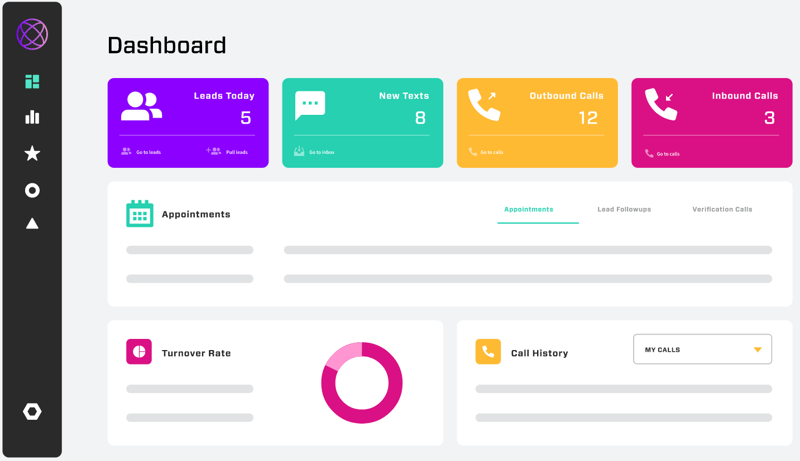
7 Proven Outbound Sales Strategies to Test Out in 2025
 Updated on
Updated on
 By Robins Dorvil
By Robins Dorvil
Robins Dorvil
With over 7 years of experience in the insurance industry, 4+ years as an Account Executive at Ringy CRM, and 17 years as a Creative Real Estate Inves...
learn more
Robins Dorvil
With over 7 years of experience in the insurance industry, 4+ years as an Account Executive at Ringy CRM, and 17 years as a Creative Real Estate Inves...
Table of Contents
Table of Contents
Mapping out your newest outbound sales plan?
You could just copy-paste your previous one…it worked o-kay…
But if last quarter's sales plan was so-so, chances are it's only going to get worse.
You need a new outbound sales strategy.
Well, lucky you, because we just happened to write an awesome blog on the best outbound sales trends of 2025, the top software to get the job done, and great examples of how to train outbound sales reps to reach their full potential.
Which blog? You landed on it.
Scroll on.
What are Outbound Sales?
Outbound sales is a method where your team actively pursues sales opportunities through pushing their message or pitching prospects.
It can involve cold emailing, social selling, digital marketing, and more.
If you're wondering, "What does outbound sales mean in today's tech-driven space?"—it's evolved. Modern outbound strategies are powered by CRM tools, data enrichment platforms, and personalized outreach techniques.
But at its core, outbound sales is still about reaching out, building relationships, and closing deals—often with people who didn't see you coming.
And no, it's not just for telemarketers or aggressive salespeople. In fact, a well-crafted outbound sales process can be consultative, data-driven, and surprisingly charming.
What is the Difference Between Inbound and Outbound Sales
What is outbound sales compared to inbound sales? Let's go over the main differences in this table.
|
Feature |
Outbound Sales |
Inbound Sales |
|
Approach |
Proactive: sales team initiates contact |
Reactive: prospect initiates contact |
|
Lead Source |
Cold lists, prospecting, data tools |
SEO, content marketing, referrals |
|
Control |
Sales controls the flow and timing |
Buyer controls when and how they engage |
|
Speed |
Faster outreach, quicker qualification |
Slower, nurtured through content |
|
Sales Cycle |
Often shorter but more aggressive |
Often longer but more qualified |
|
Common Channels |
Phone, email, LinkedIn, direct mail |
Blog, social media, search engines, email |
Outbound sales skills include prospecting, cold calling, objection handling, and follow-up. Reps need thick skin, quick thinking, and genuine curiosity to succeed. If you're looking to build an outbound sales team, look for individuals who are self-motivated, resilient, and coachable.
Not sure if you've ever done outbound sales?
Check out our blog for more in-depth info on inbound vs. outbound sales.
7 Proven Outbound Sales Strategies to Test Out in 2025

Okay, now we've got the niceties and obligations out of the way – let's get to the good stuff. We know you're here to boost your outbound sales skills with the latest tips and tricks.
Without further ado, let's dive into the 7 top outbound sales strategies.
1. Cold Calling with Pre-Sales Research
Yes, cold calling is alive—and not just clinging to life. Done right, it's still one of the fastest ways to generate pipeline.
The key? Research. Before picking up the phone, understand who you're calling. What industry are they in? What's their role? What's keeping them up at night?
Outbound sales skills like using local presence dialing (so your call looks like it's coming from the same area code) and tailoring your script to the person's actual pain points can make or break the conversation.
Tools like Ringy help streamline this with features like smart caller ID and lead tracking so reps can spend more time talking and less time fumbling.
Pro tip: Open with value, not your pitch. "Hi Sarah, I noticed your team's expanding—are you currently reviewing any sales tools?"
2. Cold Email Campaigns
Cold emails still work—if you're not boring. Think short, sharp, and skimmable. In today's inbox battleground, your subject line is your frontline. Get it right.
Make your message personalized ("I saw your recent webinar on…") and end with a clear call to action ("Would you be open to a quick call next week?").
A strong outbound sales process includes A/B testing subject lines, tracking open rates, and continuously improving based on responses. Keep your messaging human, helpful, and hyper-relevant.
3. Multi-Channel Sequences
Relying on one channel is like fishing with one line. Instead, cast a net.
Multi-channel outreach involves using a mix of:
- SMS
- Voicemail drops
- Emails
- LinkedIn DMs
- Even the occasional carrier pigeon (kidding… mostly)
These sequences work because different prospects prefer different channels. Some people ghost your emails but respond to LinkedIn messages within minutes.
A modern outbound sales strategy integrates all these touchpoints in a smart, cohesive flow. Again, a tool like Ringy allows reps to build automated sequences that still feel personal (and persistent without being annoying).
4. Lead Scoring and Target Segmentation
As you may already know, every lead is unique, which is why lead scoring is our fourth strategy for outbound sales teams.
This method helps prioritize prospects based on how well they match your Ideal Customer Profile (ICP), their engagement level, and past behaviors (like opening emails or visiting your site 3 times in 24 hours).
Smart segmentation ensures your outbound sales team isn't wasting time on tire-kickers or the eternally uninterested. Focus your efforts where they'll count.
When you know who you're reaching out to and why, your messaging hits harder and closes faster.
5. LinkedIn Outreach
LinkedIn isn't just for job hunting—it's a goldmine for outbound sales. But please, don't connect and pitch immediately. That's a great way to get ignored.
Start by:
- Engaging with their posts
- Sharing relevant content
- Commenting thoughtfully
Then slide into their DMs with context, not a copy-paste pitch.
This relationship-first approach builds trust and makes your eventual ask feel natural. Plus, LinkedIn's Sales Navigator is practically designed for high-impact outbound sales examples, especially in the B2B space.
6. Referral-Based Prospecting
Referrals are like outbound sales cheat codes. They come with built-in trust and social proof.
Train your reps to always ask happy customers, "Is there anyone else in your network who might benefit from what we offer?" You'd be surprised how often the answer is yes.
This is especially powerful if you've already built momentum with an existing client base or local community.
Bonus: these leads convert faster and close at a higher rate.
7. Outsourced SDR Teams (or AI Agents)
Let's face it: building an in-house outbound sales team takes time, money, and a serious commitment to training. If you're in rapid growth mode or just need to hit quota yesterday, outsourcing can be a smart move.
Whether you're hiring a third-party SDR team or experimenting with AI-powered agents, the key is alignment. Your outsourced team (or AI bot) needs to understand your brand voice, ICP, and goals.
When to outsource outbound sales:
- You're testing new markets.
- You need to scale fast.
- You don't have the resources to manage reps internally.
Just make sure there's a clear feedback loop so your internal team can still learn and iterate on what's working.
Outbound Sales Examples

Theory is great, but nothing beats real-world outbound sales examples to see how top reps execute. Whether you're dialing into the B2B jungle or sending cold emails that don't immediately get deleted, these examples showcase effective strategies in action.
Ready to steal like a sales artist? Let's go.
1. B2B SaaS Cold Call Script
A cold call is your first impression—and in outbound sales, it better be a good one. Here's a proven framework many successful outbound sales teams swear by.
Step-by-step Cold Call Script:
- Opener (Setup): "Hey Alex, this is Jordan from MetricStack. I know I'm calling out of the blue—mind if I take 30 seconds to explain why?"
- Value Pitch: "We help SaaS teams cut their reporting time in half with automated dashboards that don't need code or IT help."
- Objection Handling: Prospect: "We already use Tableau." You: "Totally fair—many of our clients came from Tableau. They loved the customization but found the setup slow and the licensing expensive. Would it be crazy to take a 10-minute look at something more agile?"
- Call to Action: "What does your calendar look like Thursday for a quick walkthrough?"
This kind of structured, benefit-driven cold call combines strong outbound sales skills like objection handling, concise pitching, and clear CTA delivery.
2. Cold Email for Insurance Agents
Cold emailing insurance prospects is tough—they get spammed all the time. The secret sauce? Personalization + automation.
Here's where Ringy comes in: its users in the insurance industry love it for setting up hyper-personalized sequences at scale. Think custom name drops, location-based references, and triggered follow-ups—all while sipping coffee.
Sample Cold Email Template:
Subject: Helping agents like you write more policies in less time
Hi Jamie,
I work with insurance pros across [City] to help streamline client outreach and follow-ups—especially for those juggling multiple carriers.
Our users typically see a 22% boost in response rates within the first month using [Your product's] smart sales automation.
Would you be open to a 15-minute chat on Thursday or Friday to see if it could help your agency, too?
Best,
Rachel
It's short. It's clear. It's not annoying. That's outbound sales done right.
3. SDR Multi-Touch Campaign Flow

The modern outbound sales process isn't a one-and-done. It's a multi-touch dance—timed and tailored to build trust, not fatigue.
Here's an SDR campaign flow that hits multiple channels and keeps you top of mind without being a pest.
Day 1 – Voicemail + Email
Voicemail:
"Hi Sam, this is Dylan with CloudTrack. Just left you an email—I'd love to show you how we're helping IT managers cut storage costs by 30%. Let me know if a quick chat this week works."
Email Subject: "Cloud cost savings for your team"
Email Body: Brief intro + relevant pain point + CTA link
Day 3 – SMS
"Hi Sam, Dylan here from CloudTrack—just following up on my email. Open to a 10-minute call this week?"
Day 5 – LinkedIn Follow-Up
Send a connection request with a note:
"Hi Sam, I help IT leads simplify cloud cost management. Thought it made sense to connect."
Once accepted, follow up with value-focused messaging, not a pitch bomb.
Day 7 – Call Again
"Hey Sam, wanted to circle back. Still think we can add value—let me know if I caught you at a better time."
This structured outbound sales example blends persistence with personalization. And if you're using a tool like Ringy, you can automate most of this while customizing just enough to feel human.
The Best Outbound Sales Software
Now, we aren't going to leave you twisting in the wind – the future is here, and with it we have a myriad of tools to make outbound sales easier.
There are some amazing low cost CRM programs out there.
*Note: All pricing details are accurate as of May 2025*
1. Ringy

Best for: All-in-one sales outreach and automation
Outbound sales and Ringy? They go together like ham and cheese.
Ringy is the Swiss Army knife of outbound sales software—but with fewer tools you'll never use and more features you actually will.
It rolls together:
- CRM functionality
- Built-in SMS and call tracking
- Drip email campaigns
- Appointment scheduling
That means reps can manage their entire outbound sales process—from cold text to scheduled demo—without jumping between tools.
Here's the value you can experience from using Ringy:
|
Feature |
Value |
|
Email templates |
Streamlines your prospecting |
|
Email and text drip campaigns |
Easily boost demand and lead generation |
|
Facilitate cold calls with click-to-call and local I.D. |
|
|
Task automation |
Take away tedious little to-dos so your reps can focus on pitching |
Plus, it includes detailed contact organization, data and analytics, contact and calendar integration, progressive dialers, and more.
If your outbound sales strategy needs automation without sacrificing the human touch, Ringy is worth a serious look.
Pricing: All for $109/month. Not too shabby.
2. Outreach

Best for: Enterprise-level teams needing powerful sequence automation
Outreach is built for teams who live and breathe outbound. It shines when you need to run complex, multi-touch sequences across thousands of prospects, without sacrificing personalization.
Features include:
- Email sequencing and A/B testing
- Deal management tools
- Conversation intelligence
- Analytics dashboards for managers
It's a bit of a heavyweight (and priced like one), but for large outbound sales teams, it's a performance engine. Think of it as a CRM meets outbound robot—with a brain.
Pricing: Contact sales
3. Apollo

Best for: Combining lead data with sales automation
If finding the right leads is half the battle, Apollo arms you for the war. It merges prospecting with outbound automation, letting you discover, contact, and track leads all from one platform.
Why reps love Apollo:
- Huge lead database with filters based on job titles, tech stack, funding, etc.
- One-click outreach via email or LinkedIn
- Built-in scoring to rank prospects based on ICP fit
In short, it's like having your lead research assistant and outbound coordinator all in one.
Pricing: There's a free version, but paid plans start at $49 per user, per month, billed annually.
4. Mailshake

Best for: Focused cold email campaigns with testing
Mailshake does one thing really well: cold email outreach. If your outbound sales strategy revolves around inboxes instead of phone calls, this tool is a lightweight, budget-friendly option.
Key features include:
- Automated follow-ups
- A/B testing for subject lines and email copy
- Simple campaign management
You won't get CRM-level complexity, but that's the point. Mailshake is for teams who want clean, effective email campaigns—without overkill.
Pricing: $25/month for 1 email address per account, billed annually.
5. HubSpot Sales Hub

Best for: Blending inbound with outbound outreach
While HubSpot is traditionally known for inbound marketing, its Sales Hub also offers solid tools for outbound sales.
Features include:
- Email templates and tracking
- Meeting scheduling
- Prospect pipelines
- Workflow automation
It's perfect if your team uses content to attract leads but also wants to proactively reach out. The real magic? It seamlessly blends inbound leads with outbound sales efforts, so your team doesn't miss a beat.
Pricing: There's a free version, but paid plans start from $15/month/seat, billed annually.
Outbound Sales Skills Training
You can hand someone a phone and a CRM, but without the right skills, they're just spinning their wheels. Training your outbound sales team isn't just a "nice-to-have"—it's non-negotiable if you want results that don't rely on luck.
Let's break down the must-have skills for high-performing reps—and how to actually train them.
Must-Have Outbound Sales Skills
A high-performing outbound sales rep is part detective, part psychologist, and part hype person.
Here are the core skills they need to thrive—and close.
- Prospecting: Reps should be skilled in using filters, keywords, and firmographics to build high-quality lists, not just mass email anyone with a LinkedIn profile.
- Objection Handling: Reps should learn to navigate common pushbacks like "we already have a vendor" or "not interested" with empathy, curiosity, and a value-driven response.
- Active Listening: Active listening allows reps to tailor their responses, build rapport, and identify real pain points hidden between the lines.
- CRM Fluency: It's not enough to have a CRM—reps must know how to use it efficiently. Whether it's logging notes, tracking activities, or segmenting leads, CRM fluency is vital to any repeatable outbound sales process.
- Cold Outreach Personalization: Today's outbound sales strategy demands personalization that feels authentic. Reps need to know how to tailor intros, reference specifics, and strike the right tone across channels.
- Follow-Up Mastery: Most deals don't close on the first touch (or the third). Reps need to build persistence into their DNA—knowing when to nudge, when to escalate, and when to let go.
These are the fundamentals. Without them, you're just making noise, not sales.
How to Train Your Outbound Sales Team
Training isn't a one-time onboarding PowerPoint. It's an ongoing, hands-on process that turns good reps into great closers. Here's how smart sales leaders develop serious outbound muscle:
- Role-Playing Scenarios: Practice makes perfect. Simulate real-world calls—both best-case and worst-case scenarios—to build confidence and refine delivery.
- Live Call Coaching: Listening in on live calls (with permission, of course) is one of the fastest ways to spot strengths and gaps. Offer real-time feedback or host debriefs after the call to dissect what worked and what didn't.
- Metrics-Driven Performance Reviews: Don't just ask how many calls they made. Track conversion rates, response times, and follow-up consistency. Tools like Ringy make it easy to score outreach efforts, spot patterns, and track rep improvement over time.
- Ongoing Product Knowledge Sessions: If reps don't understand the product deeply, they can't sell it convincingly. Hold regular refreshers that connect product updates to actual customer pain points.
- Use of Platforms like Ringy: Ringy isn't just for dialing and dripping—it's also a powerful training tool. Managers can review call recordings, analyze engagement metrics, and spot trends in what's resonating with prospects. Think of it as your coaching command center.
When your outbound sales team is trained and confident, they don't just hit quota—they blow past it. Focus on the right skills, deliver ongoing training, and leverage tools that make feedback easy (and actionable). That's how you build a team that doesn't just sell—they convert.
Conclusion
Pour yourself another cup of coffee and crack those knuckles – time to map out your next outbound sales plan. You definitely have enough new strategies now.
Get your sales reps social selling and guest starring on podcasts this quarter. Nail down your unique selling proposition so they can tell your prospects all about it. And don't forget that they should be practicing touting value and benefits over plain ol' features.
Remember to pick up a good outbound sales tool, too. Request a demo with Ringy, and our friendly team will definitely have a few great recommendations (heads up – they might sound a lot like our recs).

Skyrocket your sales with the CRM that does it all.
Calling? Check. SMS? Check. Automation and AI? Check. Effortlessly keep in touch with your customers and boost your revenue without limits.

Take your sales to new heights with Ringy.
Sales in a slump? Ringy gives you the tools and flexibility you need to capture leads, engage with them, and turn them into customers.
Subscribe to Our Blog
Enter your email to get the latest updates sent straight to your inbox!
Categories
Related Articles
























































































